Equipotential bonding box
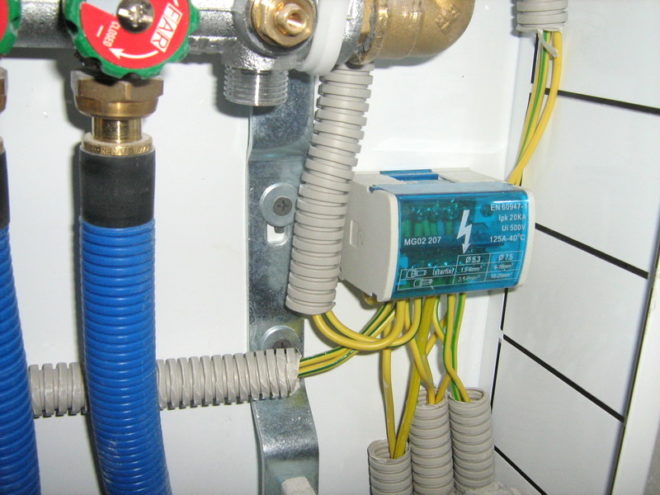
Our apartments and houses, industrial premises and offices where we work are full of metal cases and structures, during the simultaneous touch of which a person can get into the zone of potential difference. To prevent this from happening, the potentials must be equalized. How to do it in practice? Connect all current-carrying elements in the building. Such a potential equalization system (PJS) creates a safe environment for humans. One of the elements of the control system is the potential equalization box (PMC).
We will talk about these SOEs and KUPs in more detail, but first we will look at practical examples of what is the potential difference in ordinary apartments and where it comes from.
Content
The reasons
We all studied physics and remember that the potential in itself is absolutely not dangerous. The potential difference must be feared.

In apartments, the potential difference between pipes and household electrical appliances may occur due to the following circumstances:
- The insulation of the wire is damaged and current leakage occurs.
- Stray currents have occurred in the grounding system.
- The wiring diagram for electrical equipment is incorrect.
- Static electricity appears.
- Electrical devices are defective.
The danger
Remember from school? Any metallic object conducts electric current. In our homes, similar items are everywhere. These are the pipes of the central heating system, cold and hot water supply; batteries and heated towel rail; ventilation box and drain; metal case of any electrical appliance.

In general building communications, metal pipes are interconnected. Let's look at a simple example. We have a bathroom with a radiator and a shower next to it. If suddenly a potential difference arises between these two elements, and a person at the same time touches both the battery and the shower stall, it will be extremely dangerous in terms of electric shock. In this case, the human body will play the role of a jumper through which an electric current will flow. We know the path of its course from the laws of physics - from a potential with a large value to a smaller one.
Another typical example is if different potentials arise on water supply and sewerage pipes. When a current leak appears on the water pipe, there is a possibility of injury to the person while bathing in the bathroom. This will happen if a person is standing in a bathroom with water, while opening the drain and touching the water tap with his hand. To avoid such problems, potential equalization is necessary.
The situation when there is voltage on the pipes in a residential building is shown in this video:
Kinds
In order to equalize potentials, there are two systems, we will talk about each of them in more detail.
Basic equalization
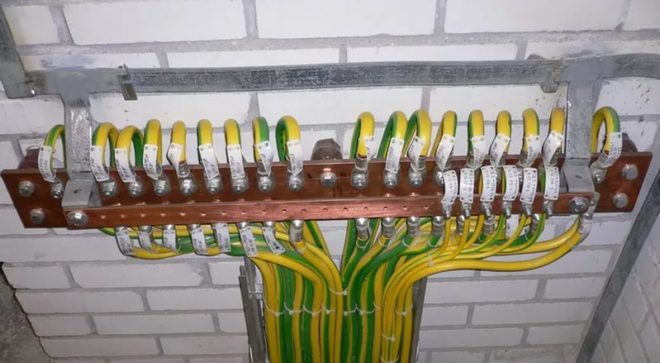
The main system of equipotential bonding is considered the main one, in an abbreviated form it is called the BPCS. In fact, this system is a contour that combines several elements:
- the most important is the main grounding bus (GZSH), it is on it that all other elements are connected;
- all metal fittings of a multi-storey residential building;
- lightning protection of the building;
- heating system;
- details and elements of elevator facilities;
- ventilation ducts;
- metal pipes for water supply and water drainage.
Each building has an input switchgear (ASU), in which the main grounding bus (GZSh) is installed. It is connected to the ground loop using a steel strip.
Previously, there was no need to worry, all metal elements were combined, and there were no prerequisites for different potentials. If any potential appeared on the pipe, along the path of least resistance, it calmly went into the ground (after all, we remember that metal is an excellent conductor).
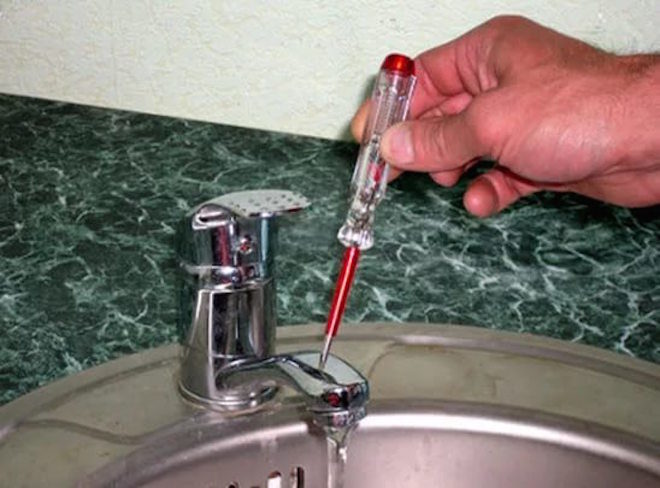
Now the situation has changed, many residents, during repair work in apartments, change metal water pipes to polypropylene or plastic. Due to this, the common chain is broken, batteries and heated towel rails are left unprotected, because the plastic is not conductive and is not connected to the ground bus. Imagine that you still have metal pipes, and the neighbor below has changed everything to plastic. When potential appears on your pipes, it has nowhere to go, the path to the ground is interrupted by the plastic pipes of your neighbor. Thus, the emergence of a potential difference occurs.
The main system has a small problem. In multi-storey buildings, communication paths are very long, due to this, the resistance of the conducting element increases. There will be a noticeable difference in the magnitude of the potential on the pipes of the first and last floors, and this is already a danger. Therefore, an additional potential equalization system is created, it is mounted on each apartment individually.
Additional equalization
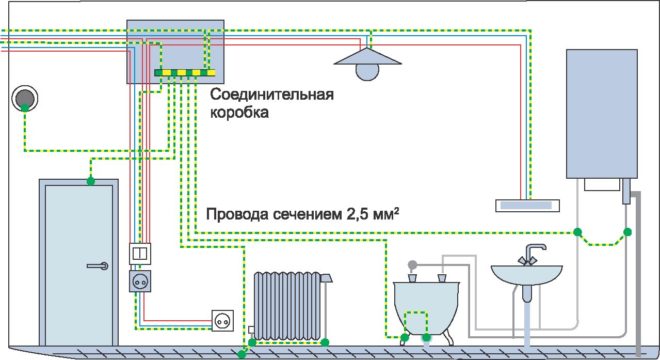
An additional potential equalization system (abbreviated name of DSPP) is mounted in bathrooms, it combines the following elements:
- metal body of a shower stall or bathroom;
- ventilation system, when its exit to the bathroom is made with a metal box;
- heated towel rail;
- sewerage;
- metal pipes for water supply, heating and gas facilities.
And here you will need a potential equalization box. A separate wire (single-core, material of execution - copper) is connected to each of the above objects, its other end is brought out and connected to the KUP.
Installation execution
KUP differs depending on how the building is structurally executed and where the box itself will be mounted:
- into a solid wall;
- into a hollow wall;
- on a wall surface (open installation method).
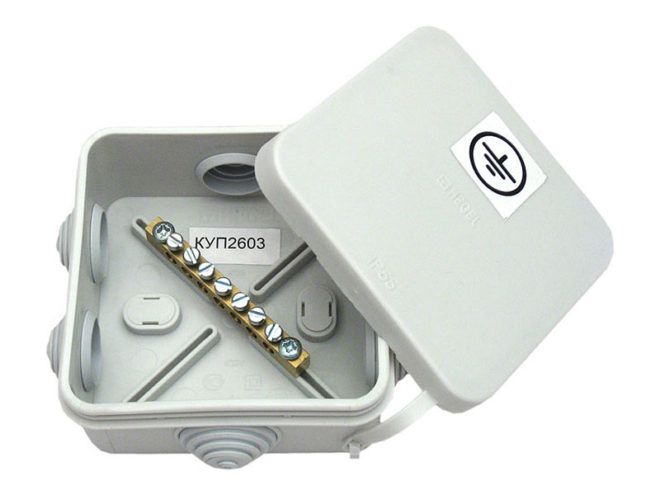
It is a housing made of plastic, inside which is the main element - the grounding bus. It is made of copper and has a cross section of at least 10 mm2.
Copper wires from objects of water supply, heating and gas systems are connected to this bus through the connectors on it; from electrical appliances located in the room, as well as from sockets and lighting fixtures installed in the bathroom.
The wires are connected to the listed elements by means of bolted connections or clamps. Sometimes special contact lugs are used, in this case the metal connection between the protected element and the wire will be especially strong. For the equipotential bonding system to work in hazardous situations, reliable contact is needed. Therefore, the place on the pipes where the clamp will be installed must be cleaned to a metallic sheen.

The internal bus is connected with a separate copper wire, called a protective PE-conductor, to the input housing panel, and through it it is connected directly to the GZSH. The cross-section of the PE conductor must be at least 6 mm2... An important condition, if you decide to lay this wire in the floor, it must not cross with other cables.
Such a box is, as it were, an intermediate link between all grounding elements and an introductory shield. It is very convenient that from each element it is enough to stretch the wiring only to the KUP, and not to the general apartment board.
When the wiring is made with plastic pipes, wires from water taps and mixers are connected to the PMC.
Before installing the EMS, you need to find out how grounding is done in the house.If according to the TN-C system (when the protective PE conductor and the working zero N are combined in one wire), equalization cannot be performed. This will pose a threat to other neighbors if they do not have such a system.
Requirements
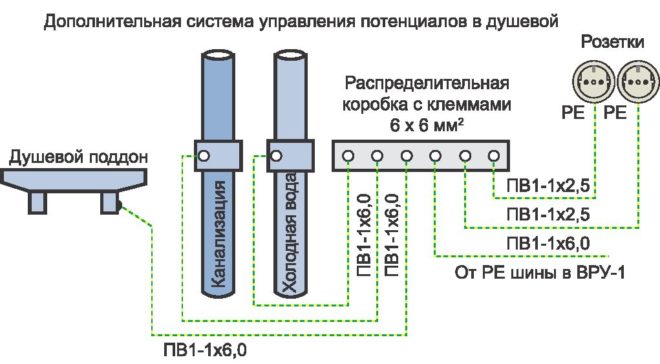
When installing the KUP, it is necessary to adhere to some requirements and rules:
- Its installation in bathrooms and toilets is required. Firstly, these rooms contain many metal cases and surfaces. Secondly, there are a lot of electrical appliances here. Thirdly, there is always high humidity in these rooms.
- The box is installed in the place where the plumbing risers pass.
- It is imperative to connect all electrical equipment to which there is open access (these are, first of all, the bodies of water heating boilers, washing machines), as well as third-party conductive elements.
- Access to the PMC must be free.
- Installation of the KUP is prohibited when grounding is installed in the house without a grounding conductor (using the grounding method).
- It is prohibited to connect the DSPC with a loop.
- DSPC along the entire length, starting from the PMC in the bathroom and up to the very introduction panel, must not be torn apart. It is forbidden to mount any switching devices in this circuit.
Finally, I would like to say, do not confuse the concepts of equalization and equalization of different potentials. To equalize means to connect conductive elements electrically to make their potentials equal. And to equalize is to reduce the potential difference on the floor or surface of the earth (step voltage).
If you have not enough experience in electricity, then do not take on such work yourself, entrust it to professionals. Among other things, at the end of the installation work, a specialist must also measure the grounding resistance and check the presence of a circuit between the grounding elements.


